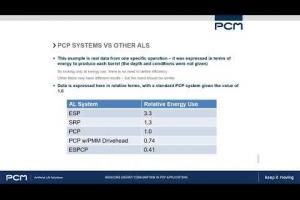ALS PCP webinars with PCM Experts
We organise PCP related webinars to allow live technical exchanges with your teams; a good opportunity to keep the link even when we cannot easily see each other face-to-face. Stay tuned for future agendas. You can easily register to the next webinars. You can also review past webinars recorded.
PCP’s are easy and reliable to operate and it is why it makes them so popular. Our Webinars are designed to address practical topics around the design and operation of PCP’s.
All our webinars include a valuable live Q&A from participants worldwide, contributing to a two-way knowledge sharing among the PCP community.
NEXT WEBINAR SESSION : Coming soon
PAST WEBINAR SESSIONS: catch up now!
We recorded for you our past webinars so that you can catch up with the sessions you missed ! You can access those sessions anytime you want without subscribing and as many times as you want.
💻 PCM SLUGGER - THE HYDRAULICALLY-REGULATED PCP - September 2023
In this webinar, PCM’s Paul Skoczylas and Pat Brodbin present the PCM Slugger Hydraulically Regulated Progressing Cavity Pump. This includes some background information about the technology and a review of previously published information from around the world, but the focus is on the experiences of PCM’s Canadian customers using the PCM Slugger.
💻 REDUCING ENERGY CONSUMPTION IN PCP APPLICATIONS - June 2022
Reducing energy consumption in an Artificial Lift System (ALS) can be important for many reasons. These can include cost, power availability, and carbon footprint.
Progressing Cavity Pump (PCP) systems are known to be the most energy-efficient form of ALS in many applications. But there can be a wide range of efficiency for a PCP system depending on the application and on the choices of the system’s designer and maintenance crews.
In this webinar, we will look at ways to reduce the energy consumption of ALS systems using PCPs. Topics will include pump selection, rod and tubing design, and selection and maintenance of drive equipment.
💻 PCP ROD STRING FATIGUE - March 2022
Fatigue failures of the rod string are a common problem in PCP systems in deviated and horizontal wells. Fatigue failures occur in the rod body, not within the connection. Most often they occur very near the connection, but they can also occur at other places if there was significant corrosion or if there was previous damage to the rod.
In this webinar we will look at how to identify a rod fatigue failure and how to modify the PCP system design to reduce fatigue failures in future installations. The effects of the pump size, rod diameter and rod grade will be discussed along with the effect of the types of couplings, guides, and centralizers.
💻 MONITORING PCP WELLS - WHAT INSTRUMENTATION SHOULD YOU HAVE? - November 2021
There is a wide range of practices used around the world in monitoring PCP wells. These can range from an operator taking a fluid shot to measure the fluid level once a month, to complete systems of downhole gauges. The more instrumentation there is in a well, the more information is available to assist the production teams in optimizing the performance and run-life of their equipment. Some data can also be very valuable to the reservoir engineering teams. However, any monitoring system comes with a cost, so there is a balance between the cost of the system and the value it provides.
In this webinar, we will discuss the different options available for monitoring PCP wells. We will look at the advantages and disadvantages of several forms of downhole and surface monitoring systems. We will see what value can be obtained from each, and how they can be used in both optimizing the well performance and reducing the frequency of failures.
💻 PCP ROTOR SIZING - September 2021
Progressing cavity pumps are an excellent form of artificial lift (AL) in many applications. While they technically out-perform other AL systems in certain applications (for example pumping very viscous fluids or fluids with high solids content), they can have better economics than other AL systems in a wide range of applications. However, good economic results depend on good pump performance and run-life. One thing that makes PCPs different from other AL systems is the elastomer, and the interference fit between the rotor and stator. Elastomers behave differently from steel, and in particular, they can expand due to both chemical and thermal effects. This expansion affects the fit between the rotor and stator. Getting the fit right in consideration of this expansion is important in achieving both good performance and good run-life.
In this webinar, we have discussed the importance of rotor sizing, how rotor sizes are selected, and what the effects of different rotor sizing can be. We have looked at how PCM selects rotor sizes, as well as other methods that are used. We also looked at how elastomer pump and rotor geometry affect rotor sizing.
We went beyond theory and look at operational aspects to provide some advice and recommendations on selecting, operating, and optimizing pumps both in new and existing applications.
💻 PCP GEOMETRY IN HIGH-SOLIDS APPLICATIONS - April 2021
Progressing cavity pumps are recognized as the best form of artificial lift in wells that produce solids. However, when there are a lot of solids, it is important to select the best pump geometry for the application.
In this recorded webinar you will discover the different ways of considering the geometry of a PCP, and how the optimum geometry can help move solids through the pump. We will also consider methods of helping to keep solids moving at the pump intake and through the tubing.
💻 ALS PCP MYTHS & TRUTHS (PART #2) - November 2020
Are you wondering about progressing cavity pumps features and use in the ALS market? You do not really know whether some information are true or false?
- Hole Angle: A PCP cannot be run at 90°
- Efficiency: A good PCP should have test bench efficiency of 60-80%
- Torque Anchor: Every PCP system needs a torque anchor installed
- Choke: Choking the tubing is a way to reduce free gas at the pump intake
- Installation: When the rotor enters the stator during installation, the rig crew will see the rod string rotate
- High DLS: When there is high dogleg severity, the use of pony rods and/or rod guides can help improve system run life
💻 ALS PCP MYTHS & TRUTHS (PART #1) - September 2020
Are you wondering about progressing cavity pumps features and use in the ALS market? You do not really know whether some information are true or false?
- Space out: Need 1 ft space out for every 1000 ft of rod
- AMPCP: AMPCP cannot pump water
- Efficiency: Low volumetric efficiency while operating in the well is always bad
- Gas: PCPs do not gas lock
- Rod: No backspin after a stop = parted rod
- Light oil: PCP is not a good choice for pumping high API oil
- Explosive decompression: Slow STOP & POOH will reduce risk of explosive decompression
💻 ROD STRING MAKE-UP - June 2020
Frequent Rod Failures? Find out simple tricks to eliminate 90% of those cases.
LET US KNOW WHICH TOPICS YOU WANT FOR OUR FUTURE WEBINARS
Are you eager to know more on a given topic we have not yet covered ? We will be pleased to consider your suggestion to propose you a technical webinar addressing exactly your expectations.








